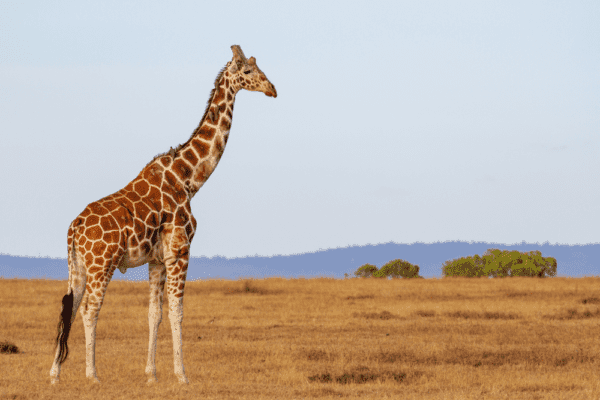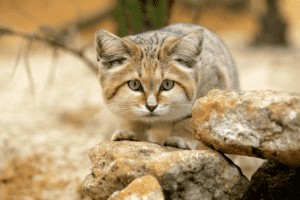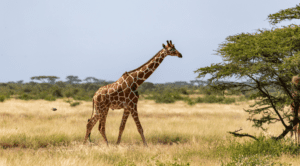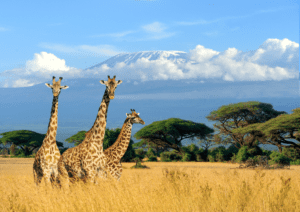Giraffes have been on the earth for around 32 million years, and up until recently, they roamed the plains of Africa in large numbers. But now, these animals are endangered, why is this happening? Let’s take a closer look at what is causing the decline of giraffes and some possible solutions.
Why giraffes are endangered is due to habitat loss. Giraffes rely on a specific type of vegetation for food, and as humans continue to encroach on their natural habitats, there is less and less food available for them. In addition, giraffes are often hunted for their meat and their horns, which are used in traditional medicines.
Table of Contents
Reasons: Why Are Giraffes Endangered
There are the following reasons why are giraffes endangered:
Slow reproductive rate
The main reason why giraffes are endangered due to the fact that they have a very slow reproductive rate. Giraffes only give birth to one calf at a time, and it takes 15 months for that calf to be born. This means that it takes a long time for the population to increase, which makes it difficult to recover from any losses.
Climate change
Another reason why giraffes are endangered is due to climate change. Giraffes are very sensitive to changes in temperature and rainfall, and as the climate continues to change, their habitats are becoming increasingly unlivable.
Disease
The 3rd reason why giraffes are endangered is due to disease. Just like any other animal, giraffes can fall prey to various diseases that can decimate the population. For example, a recent outbreak of anthrax killed over 500 giraffes in Uganda.
Human-wildlife conflict
The fourth reason why giraffes are endangered is due to human-wildlife conflict. As humans continue to expand into giraffe territory, there is more and more conflict between the two species.
Giraffes are often killed by farmers who see them as a threat to their crops, or they get hit by cars as they try to cross busy roads.
Poaching
The fifth reason why giraffes are endangered is due to poaching. Poachers kill giraffes for their meat, horns, and skin. The demand for these products is high, which makes giraffes a target for poachers.
Illegal wildlife trade
The sixth reason why giraffes are endangered is due to the illegal wildlife trade. Giraffes are often captured and sold into the black market, where they are used for entertainment or kept as exotic pets.
Human population growth
The final reason why giraffes are endangered is due to human population growth. As the human population continues to grow, there is more pressure on natural resources, which means that giraffes are losing their habitat to development.
How To Protect Giraffes

One way to help giraffes is to support organizations that are working to protect them and their habitats. You can also spread the word about why it’s important to save these animals.
Educate others about the importance of saving giraffes. Finally, you can donate money to groups working to conserve giraffes and their habitats. Speak up and demand action from governments and businesses.
We can all play a role in saving these animals, but it’s going to take a concerted effort from everyone to make sure that giraffes don’t disappear from the earth entirely. Let’s not wait until it’s too late. Act now and help save these magnificent creatures.
What protections do giraffes have under U.S. regulation?
The U.S. Fish and Wildlife Service regulates the import of giraffes and their body parts under the Convention on International Trade in Endangered Species of Wild Fauna and Flora (CITES).
This is an international agreement that helps to protect endangered plants and animals by controlling their trade of them. Giraffes are listed in Appendix II of CITES, which means that their trade is regulated in order to avoid them becoming endangered.
Giraffes Facts
There are the following interesting facts about giraffes:
- Giraffes are the tallest living land animals. The average height of a giraffe is 18 feet (about half a basketball court).
- Giraffes weigh between 1800 and 2600 pounds.
- Male giraffes are called bulls, females cows, and the young are called calves.
- Giraffes can live up to 25 years in the wild and even longer in captivity.
- A group of giraffes is called a tower.
- The scientific name for a giraffe is Giraffa camelopardalis.
- Giraffes are related to deer and cattle, but their closest living relative is actually the okapi.
- Giraffes are herbivores and their diet consists mostly of leaves from trees and bushes.
- Giraffes use their long necks to reach leaves that other animals can’t.
- They also use their tongues, which are about 18 inches long, to strip the leaves off the branches.
Giraffe Population and Conservation Status by Species

The International Union for the Conservation of Nature (IUCN) lists all giraffe subspecies as “vulnerable,” with some on the brink of extinction. The organization reports that there are approximately 97,000 giraffes in the wild, down from 152,000 in 1985 and more than one million a century ago.
There are the following recognized giraffe subspecies, and all are experiencing population declines:
Southern Giraffe:
Population: 26,300
Scientific Name: Giraffa giraffa
North African Giraffe:
Population: less than 250
Scientific Name: Giraffa camelopardalis
Reticulated Giraffe:
Population: less than 15,000
Scientific Name: Giraffa reticulata
West African Giraffe:
Population: less than 500 (functionally extinct)
Scientific Name:Giraffa camelopardalis peralta
Angolan Giraffe:
Population: unknown but likely fewer than 20,000
Scientific Name:Giraffa camelopardalis angolensis
Kordofan Giraffe:
Population: less than 4000 (possibly as few as 2000)
Scientific Name: Giraffa camelopardalis antiquorum Masai giraffe: The scientific name of Masai giraffe is Giraffa tippelskirchi.
Masai giraffe:
Population: 32,500
Scientific name: Masai giraffe is Giraffa tippelskirchi
How many giraffes are left in the world:
There are approximately 68,000 giraffes left in the world. Their populations have declined by 40% over the last three decades. If this trend continues, giraffes could be extinct in the wild within our lifetime.
How many giraffes are killed each day?
The answer to this question is difficult to determine because giraffes are not a species that is commonly tracked by wildlife officials. However, it is estimated that approximately 100 giraffes are killed each day by poachers.
This number has been on the rise in recent years due to the growing demand for giraffe parts on the black market.
How many white giraffes are left in the world?

There are only two known white giraffes left in the world and they both live in Kenya. The first was discovered in 2015 by conservationists in the Ishaqbini Hirola Conservancy and was named Omo. The second white giraffe was found earlier this year and was named hope.
What is the lifespan of a giraffe?
The lifespan of a giraffe is about 25 years. However, in the wild, they often only live to be 15 or 20 years old. The main reason for this is because of predators.
What are the predators of giraffes?
The main predators of giraffes are humans, lions, and leopards. These animals kill giraffes for their meat and skins. In some areas, giraffes are also hunted for their horns, which are used in traditional Chinese medicine.
Why do giraffes have such long necks?
The answer to this question is still a bit of a mystery. Some scientists believe that the long necks of giraffes give them an advantage when it comes to feeding. They can reach leaves and buds that other animals can’t, which gives them a competitive edge in terms of food.
Drawbacks:
However, there are also some drawbacks to having such a long neck. For one, it makes giraffes more vulnerable to predators. And secondly, it means that they have to spend more energy maintaining their body temperature.
Why do giraffes have spots?

Giraffes have spots because they are born with them. The spots help the giraffe blend in with its surroundings and protect it from predators.
How many Nubian giraffes are left?
The Nubian giraffe is one of the most endangered animals on the planet. They are found only in Ethiopia and Sudan and their populations have declined sharply in recent years.
There are thought to be less than 2500 Nubian giraffes left in the wild. This is a massive decline from just a few decades ago when there were an estimated 15,000 Nubian giraffes living in the wild.
Can humans eat giraffes?
The simple answer is yes, humans can eat giraffe meat. However, due to the animal’s endangered status and low population numbers, it is not advised. Hunting giraffes for food is illegal in many countries, as it should be.
Not only is this majestic creature a national symbol of several African countries, but it also plays an important role in the ecosystem.
How does a giraffe drink?

A giraffe can drink up to 12 liters of water a day. They often drink early in the morning and late at night when it is cooler. When they drink, it bends down to the ground, bringing its neck and head level with a water hole, and then uses its long tongue to scoop up the water.
It then closes its mouth and swallows. Giraffes usually only drink once every few days, although they will drink more frequently if water is scarce or the weather is hot.





